You probably will have arrived on this page by choosing a green-flowered plant from the flower colours pages. A number of plant groups have tight bunches of small, green flowers, often so small that they may even be completely overlooked by anyone not familiar with such plants. Green-flowered plants are most often wind-pollinated, so they don't need brightly-coloured petals to attract insects. Typically in such plants, the petals are absent and what appear to be petals are really only sepal-like structures. Since such segments of the flower are not quite sepals and not quite petals, they are often referred to as tepals and this term is used here, where necessary. A great majority of the plants in this group are members of the goosefoot and amaranth family; such plants are often abundant on farmland and other disturbed areas, or in saltmarshes, so goosefoots, oraches and amaranths will be regular pages to check if you are looking at plants in those habitats.
The main purpose of this page is to attempt to break this group up into bite-sized chunks, so that the pages you are led to do not get too big by containing a large number of species. At worst, if you follow a link from here and do not see your plant, return to this page and try another link.
At this stage, be sure to read the texts below carefully, as they contain identification information that may not be visible in the photographs; clicking on the picture will take you to the next stage and help you get to the exact species. It is important at this stage to consider the position of the flowers on the plant (in the leaf axils or clustered at the top of the plant, for example) and to consider the overall appearance of the plant itself. Some of the plants in this group are described as 'fleshy' or 'succulent'. These are plants that have a noticeable thickness to the leaves and/or stems and are often quite watery inside. Some are also described as 'mealy'; mealiness is usually caused by the plant being covered in strange, silvery scales which often rub off. These scales are usually highly adapted hairs that are inflated like little bladders and are most common in plants that grow in salt-laden habitats.
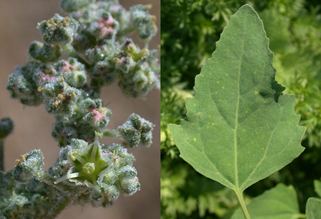 |
Goosefoots
Widespread and often abundant on disturbed soil on farmland, gardens, roadsides and similar places. Plants may be low and spreading, or reaching two metres in height. Leaves and stems usually dull green with a slightly fleshy feel. Leaves very variously shaped (even on a single plant), from narrow and grass-like to broadly spear-shaped or triangular, often with lobed or broadly-toothed margins. Flowers usually in terminal spikes, very densely packed and often covered in mealy scales. Flowers are 'perfect', having female stigmas at the centre with two to five male stamens around them - this is an important distinction from the oraches, which have male and female parts in separate flowers. |
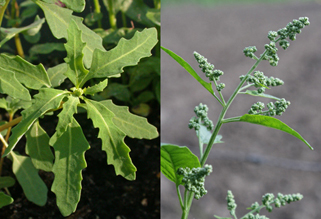 |
Goosefoots
Widespread and often abundant on disturbed soil on farmland, gardens, roadsides and similar places. Plants may be low and spreading, or reaching two metres in height. Leaves very variously shaped (even on a single plant), from narrow and grass-like to broadly palmate (like maple leaves) or triangular, often with lobed or broadly-toothed margins. Flowers usually in dense or openly-branched, terminal spikes, very densely packed and often covered in mealy scales. Flowers are 'perfect', having female stigmas at the centre with two to five male stamens around them - this is an important distinction from the oraches, which have male and female parts in separate flowers. |
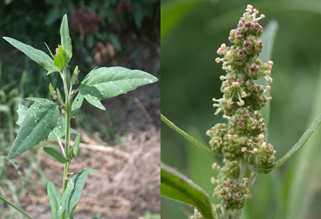 |
Oraches
Widespread and often abundant on disturbed soil on farmland, gardens, roadsides and similar places. Plants may be low and spreading, or slightly ascending. Leaves very variously shaped, even on the same plant, from narrow and grass-like to broadly spear-shaped or triangular, often with lobed margins. Flowers usually in terminal spikes, very densely packed and often covered in mealy scales. Flowers are either male or female, some flowers having just female stigmas at the centre, others having just two to five male stamens - this is an important distinction from the goosefoots, which have all flowers with both male and female parts. Female flowers are very hard to see, being buried deep within a pair of stiff bracteoles. |
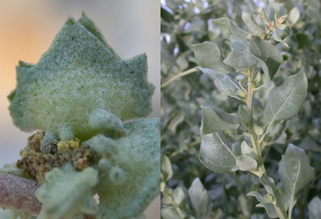 |
Oraches
Plants of coastal sands, shingle beaches and saltmarshes. Plants may be low and spreading, or slightly ascending, annuals or shrubby perennials, often with a silver-metallic look from a dense covering of whitish scales. Leaves very variously shaped, even on the same plant, from narrow and grass-like to broadly spear-shaped or triangular, often with lobed margins. Flowers usually in terminal spikes, very densely packed and often covered in mealy scales. Flowers are either male or female, some flowers having just female stigmas at the centre, others having just two to five male stamens - this is an important distinction from the goosefoots, which have all flowers with both male and female parts. Female flowers are very hard to see, being buried deep within a pair of stiff bracteoles. |
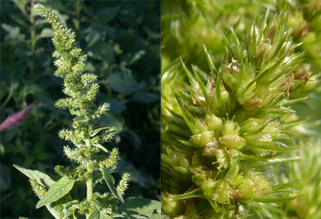 |
Amaranths & Pigweeds
These are plants of disturbed ground, commonly found as weeds of enriched soils such as on farmland, gardens and allotments. Plants may be low and mat-forming, or tall - even to above head height! With their green, petalless flowers, these are rather uninspiring plants with mostly rather coarse, wavy-edged leaves and tiny flowers carried in large masses and buried within very spiky bracts. Most tall species have spike-like, conspicuous flower clusters, while the lower-growing species have smaller clusters of flowers carried in the leaf axils. The leaves often (though not always) have a pale blotch on them. |
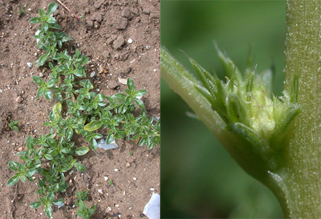 |
Amaranths & Pigweeds
These are plants of disturbed ground, commonly found as weeds of enriched soils such as on farmland, gardens and allotments. Plants may be low and mat-forming, or tall - even to above head height! With their green, petalless flowers, these are rather uninspiring plants with mostly rather coarse, wavy-edged leaves and tiny flowers carried in large masses and buried within very spiky bracts. Most tall species have spike-like, conspicuous flower clusters, while the lower-growing species have smaller clusters of flowers carried in the leaf axils. The leaves often (though not always) have a pale blotch on them. |
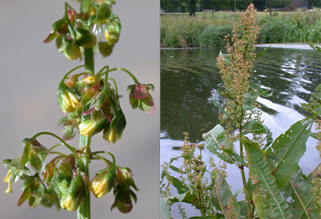 |
Docks
This is a well known group of plants with open, well-branched flower spikes of petalless flowers. The flowers have prominent, yellow anthers hanging from them when they are fully developed. Docks are plants of damp places or of disturbed, nitrogen-rich places such as gardens, arable fields, roadsides and rough ground. Many species have large leaves that are clustered at the base of the plant, although some wetland species have narrower, elongate leaves. The species are all rather similar in their flowers and are best told apart by their seed capsules. |
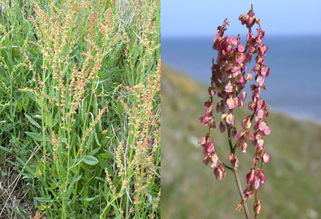 |
Sorrels
Sorrels are small species of dock that may form small rosettes of relatively large leaves, or may have creeping stems that form large, spreading mats of small leaves. The flowers are tiny and carried in many-branched spikes, often tinged reddish in colour. The seed capsules are also tinged red and are brightly coloured enough to be easily mistaken for flowers. Note that other, unrelated plants are also often called sorrels - such as members of the genus Oxalis, but these are very different in appearance. |
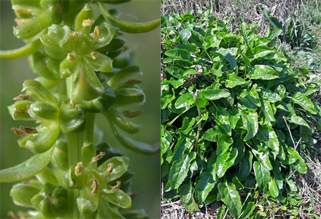 |
Beets & Spinachs
Stout, leafy, dock-like plants, the leaves usually shiny and deep green, sometimes purple-tinged. Flowers are petalless but with five prominent, green sepals, packed into upright, branched spikes. |
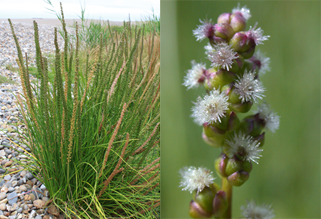 |
Arrowgrasses
Wetland plants (both fresh and saltwater) growing to around 30-60cm in height with linear, grass-like but fleshy leaves. The leaves appear in a basal rosette and the tiny flowers are carried in a narrow, upright spike. The flowers have six, greenish, tepals (sepal-like petals) and a fuzzy, white pompon of stigmas. |
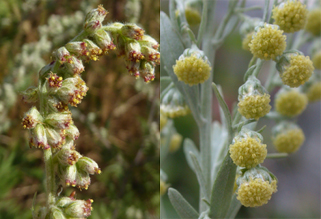 |
Wormwoods, Mugworts & Ragweeds
The mugworts and wormwoods include species grown as herbs and ornamental garden plants, as well as a few natives. The flowers consist of tight clusters of 'florets' without an outer array of obvious petals, with these compound flowers carried in many-branched heads at the top of the stems, above the leaves. Many species are silver-hairy and most have deeply cut and divided leaves. All species are highly aromatic in all their parts. The ragweeds are similar but are annuals. |
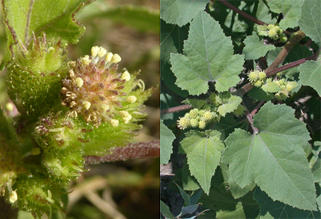 |
Cockleburs
These are rather unusual members of the daisy family that are rather rare introductions but which occasionally turn up from unusual sources, such as from birdseed. The petalless flowers are tiny and carried in tight bundles in the leaf axils. Their bases carry obvious clusters of strongly hooked spines which are soft when in flower, but enlarge and become stiff as the seed capsules develop. The leaves may be broad and lobed or toothed, or they may be sharply pointed and carried on spiny stems. |
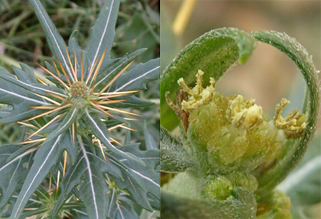 |
Cockleburs
These are rather unusual members of the daisy family that are rather rare introductions but which occasionally turn up from unusual sources, such as from birdseed. The petalless flowers are tiny and carried in tight bundles in the leaf axils. Their bases carry obvious clusters of strongly hooked spines which are soft when in flower, but enlarge and become stiff as the seed capsules develop. The leaves may be broad and lobed or toothed, or they may be sharply pointed and carried on spiny stems. |
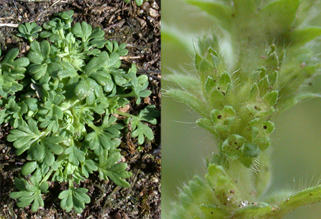 |
Parsley-pierts
Low-growing or shortly upright plants, often only a few centimetres in height, with parsley-like leaves. The tiny green flowers appear in clusters along the upper stems, opposite the leaves and are surrounded by a frilly 'ruff' that surrounds the stems at the leaf nodes. Plants of open, usually dry and often sandy soils, especially where disturbed, such as on arable farmland, dirt tracks, allotments etc. |
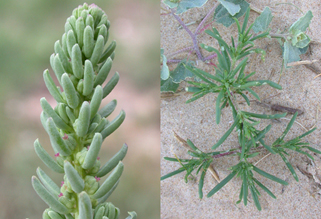 |
Sea-blites, Saltworts and Allies
These are mostly plants of saltmarsh or coastal sand and shingle, though some species may occur as introduced novelties on roadsides and waste ground inland. Leaves vary but are usually linear and succulent, sometimes with a spiny tip. Summer-cypress has flattened, linear leaves. |
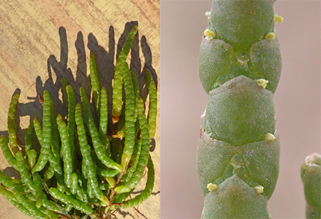 |
Glassworts
Often called samphire or marsh samphire in East Anglia, these plants are abundant in saltmarsh and on intertidal mud around the region's coasts. They are peculiar little plants, mostly growing to 20cm or less in height and consisting of a series of short, segmented, succulent and glossy stems. The flowers are sunken into the stems and are easily overlooked as they are very unflower-like in appearance, revealing their presence only when the tiny yellow stamens or white stigmas protrude a short way. |